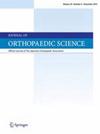评估肩胛下肌撕裂:特殊测试与疼痛和撕裂严重程度之间的关系。
IF 1.5
4区 医学
Q3 ORTHOPEDICS
引用次数: 0
摘要
背景:本研究旨在探讨肩胛下撕裂的特殊测试与疼痛和撕裂严重程度之间的关系:本研究旨在探讨肩胛下撕裂的特殊检查与疼痛和撕裂严重程度之间的关系:2010年至2022年期间,经关节镜确诊为肩胛下撕裂的92例患者(145例为孤立性病变,757例为合并性病变)。肩胛下撕裂的严重程度根据拉弗塞分类法 I、II、III 和 IV 型进行分类。记录了患者术前静息时的视觉模拟量表(VAS)疼痛评分、肩关节的屈曲和外展活动范围(ROM)以及提举试验(LOT)、腹压试验(BPT)、熊抱试验(BHT)和空罐试验(ECT)的结果:单独和合并撕裂的 LOT 灵敏度分别为 70.3% 和 69.5%,BPT 灵敏度分别为 45.6% 和 41.2%,BHT 灵敏度分别为 72.1% 和 72.6%,ECT 灵敏度分别为 81.2% 和 84.1%。肩胛下撕裂的严重程度与所有特殊测试的灵敏度之间没有关联(P > 0.05)。在多变量逻辑回归分析中,只有 ECT 与疼痛有关(OR = 33.1,p 结论):除 ECT 外,用于评估肩胛下撕裂的特殊测试对撕裂的严重程度和疼痛都不敏感。BHT 是检测任何肩胛下撕裂的最成功的检测方法,无论是孤立性撕裂还是合并性撕裂。疼痛的严重程度与肩胛下肌病变同时存在肩袖病变有关,但与肩胛下肌或其余肩袖撕裂的严重程度无关:研究设计:证据等级III,横断面档案研究:由于该研究是一项回顾性档案研究,因此没有临床试验注册。本文章由计算机程序翻译,如有差异,请以英文原文为准。
Assessing subscapularis tears: Relationship between special tests and pain & tear severity
Background
The objective of this study is to examine the association between special tests for subscapularis tears and both pain and tear severity.
Methods
Nine hundred and two patients (145 with isolated lesions and 757 with combined lesions) diagnosed with arthroscopically confirmed subscapularis tears between 2010 and 2022. Subscapularis tear severity was classified according to Lafosse classification type I, II, III and IV. Preoperative Visual Analogue Scale (VAS) pain score at rest of the patients, flexion and abduction range of motion (ROM) of the shoulder and the results of the Lift-off test (LOT), Belly Press test (BPT), Bear Hug test (BHT), and Empty Can test (ECT) were documented.
Results
The sensitivity of LOT in isolated and combined tears was 70.3 % and 69.5 %, 45.6 % and 41.2 % of BPT, 72.1 % and 72.6 % of BHT, 81.2 % and 84.1 % of ECT, respectively. There was no association between the severity of the subscapularis tear and the sensitivity in all special tests (p > 0.05). Only the ECT was observed to be associated with pain in the multivariate logistic regression analysis (OR = 33.1, p < 0.001).
Conclusions
The special tests used to evaluate subscapularis tears are neither sensitive to the severity of the tear nor to pain except for ECT. BHT is the most successful test to detect any subscapularis tear in both isolated and combined tears. Pain severity was related to the presence of a rotator cuff lesion accompanying subscapularis lesion, but not with the severity of subscapularis or remaining rotator cuff tear.
Study design
Levels of Evidence III, cross-sectional archive study.
Clinical trial registration number
Since the study was a retrospective archive study, there was no clinical trial registration.
求助全文
通过发布文献求助,成功后即可免费获取论文全文。
去求助
来源期刊

Journal of Orthopaedic Science
医学-整形外科
CiteScore
3.00
自引率
0.00%
发文量
290
审稿时长
90 days
期刊介绍:
The Journal of Orthopaedic Science is the official peer-reviewed journal of the Japanese Orthopaedic Association. The journal publishes the latest researches and topical debates in all fields of clinical and experimental orthopaedics, including musculoskeletal medicine, sports medicine, locomotive syndrome, trauma, paediatrics, oncology and biomaterials, as well as basic researches.
 求助内容:
求助内容: 应助结果提醒方式:
应助结果提醒方式:


